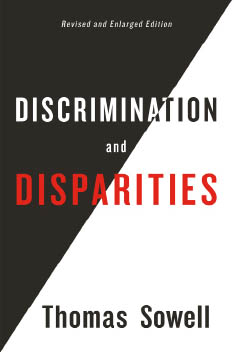|
Discrimination and Disparities is a radical book, in the fundamental sense of going to the root of an issue. It challenges the very foundation of assumptions on which the prevailing “social justice” vision is based. The first two chapters of Discrimination and Disparities present a new framework of analysis, and back it up with empirical evidence from around the world, before proceeding to demonstrate why and how so much of the "social justice" vision is a house of cards. Some readers may be surprised to discover what elementary fallacies provide the basis for many often-repeated assertions about the “top 10 percent,” the “top one percent” or the “top 400” highest income recipients. The numbers behind such assertions may be valid as of a given moment, but most people's lives last longer than a moment. At some time during their lives, just over half of all Americans are in the “top 10 percent” in income. Internal Revenue Service data show that, over a 23-year period, there were 4,584 people in the “top 400”— and most of them were in that bracket just one year out of more than two decades. In many contexts, turnover is the ignored elephant in the room. Discrimination and Disparities points out many other elephants that have been ignored for far too long. The fact that life has never been even approximately “fair,” in the sense of presenting equal chances for achievement to all individuals, groups or nations is undeniable. But that tells us nothing about the particular causes of particular skewed outcomes. Nor does this mean that we can reduce the causes to whatever fits a particular social vision, without putting that vision to the test of empirical evidence. This does not require fatalistic acceptance of economic and social disparities. It does suggest that much of what is said and done in the name of “social justice” is an impediment to creating greater opportunities for all. Teachers who want their students to see more than one side of issues may find Discrimination and Disparities especially valuable for that purpose.
******** Available from amazon.com |
